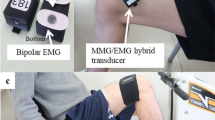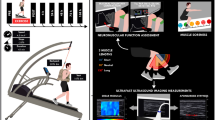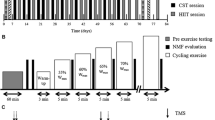Abstract
Purpose
The partitioning of the electromechanical delay by an electromyographic (EMG), mechanomyographic (MMG) and force combined approach can provide further insight into the electrochemical and mechanical processes involved with skeletal muscle contraction and relaxation. The aim of the study was to monitor by this combined approach the changes in delays’ electrochemical and mechanical components throughout a fatiguing task and during recovery in patients with myotonic dystrophy type 1 (DM1), who present at the skeletal muscle level fibres rearrangement, muscle weakness and myotonia, especially in the distal muscles.
Methods
After assessing maximum voluntary contraction (MVC), 14 male patients with DM1 and 14 healthy controls (HC) performed a fatiguing exercise at 50% MVC until exhaustion. EMG, MMG, and force signals were recorded from tibialis anterior and vastus lateralis muscles. The electromechanical delay during contraction (DelayTOT) and relaxation (R-DelayTOT) components, EMG and MMG root mean square (RMS) and mean frequency (MF) were calculated off-line.
Results
The fatiguing exercise duration was similar in both groups. In patients with DM1, delays components were significantly longer compared to HC, especially in the distal muscle during relaxation. Delays components recovered quickly from the fatiguing exercise in HC than in patients with DM1 in both muscles.
Conclusions
The alterations in delays observed in DM1 during the fatiguing exercise may indicate that also the lengthening of the electrochemical and mechanical processes during contraction and relaxation could play a role in explaining exercise intolerance in this pathology.








Similar content being viewed by others
Abbreviations
- DelayTOT :
-
Total electromechanical delay during contraction
- DM1:
-
Myotonic dystrophy type 1
- Δt :
-
Delays during contraction
- EMG:
-
Electromyogram
- F :
-
Force
- HC:
-
Healthy controls
- HRT:
-
Half relaxation time
- MF:
-
Mean frequency
- MMG:
-
Mechanomyogram
- MVC:
-
Maximum voluntary contraction
- R-DelayTOT :
-
Total electromechanical delay during relaxation
- RFD:
-
Rate of force development
- RMS:
-
Root mean square
- R-Δt :
-
Delays during relaxation
- SEC:
-
Serial elastic component
- TA:
-
Tibialis anterior muscle
- VL:
-
Vastus lateralis muscle
References
Ament W, Verkerke GJ (2009) Exercise and fatigue. Sports Med 39(5):389–422. doi:10.2165/00007256-200939050-00005
Angelini C, Tasca E (2012) Fatigue in muscular dystrophies. Neuromuscul Disord 22(Suppl 3):S214–S220. doi:10.1016/j.nmd.2012.10.010
Barchi RL (1975) Myotonia. An evaluation of the chloride hypothesis. Arch Neurol 32(3):175–180
Birnberger KL, Klepzig M (1979) Influence of extracellular potassium and intracellular pH on myotonia. J Neurol 222(1):23–35
Boerio D, Lefaucheur JP, Bassez G, Hogrel JY (2012) Central and peripheral components of exercise-related fatigability in myotonic dystrophy type 1. Acta Neurol Scand 125(1):38–46. doi:10.1111/j.1600-0404.2011.01497.x
Bouillard K, Nordez A, Hug F (2011) Estimation of individual muscle force using elastography. Plos One 6(12):e29261. doi:10.1371/journal.pone.0029261
Camic CL, Housh TJ, Zuniga JM, Bergstrom HC, Schmidt RJ, Johnson GO (2014) Mechanomyographic and electromyographic Responses during fatiguing eccentric muscle actions of the leg extensors. J Appl Biomech 30(2):255–261. doi:10.1123/jab.2013-0178
Cavanagh PR, Komi PV (1979) Electromechanical delay in human skeletal muscle under concentric and eccentric contractions. Eur J Appl Physiol Occup Physiol 42(3):159–163
Ce E, Rampichini S, Agnello L, Limonta E, Veicsteinas A, Esposito F (2013) Effects of temperature and fatigue on the electromechanical delay components. Muscle Nerve 47(4):566–576. doi:10.1002/mus.23627
Ce E, Rampichini S, Limonta E, Esposito F (2014) Fatigue effects on the electromechanical delay components during the relaxation phase after isometric contraction. Acta Physiol (Oxf) 211(1):82–96. doi:10.1111/apha.12212
Ce E, Rampichini S, Venturelli M, Limonta E, Veicsteinas A, Esposito F (2015) Electromechanical delay components during relaxation after voluntary contraction: reliability and effects of fatigue. Muscle Nerve 51(6):907–915. doi:10.1002/mus.24466
Ce E, Rampichini S, Monti E, Venturelli M, Limonta E, Esposito F (2016) Changes in the electromechanical delay components during a fatiguing stimulation in human skeletal muscle: an EMG, MMG and force combined approach. Eur J Appl Physiol. doi:10.1007/s00421-016-3502-z
Cè E, Rampichini S, Esposito F (2015) Novel insights into skeletal muscle function by mechanomyography: from the laboratory to the field. Sport Sci Health 11:1–28. doi:10.1007/s11332-015-0219-z
Cohen J (1988) Statistical power analysis for the behavioral sciences. Lawrence Erlbaum associates, Hillsdale
Damiani E, Angelini C, Pelosi M, Sacchetto R, Bortoloso E, Margreth A (1996) Skeletal muscle sarcoplasmic reticulum phenotype in myotonic dystrophy. Neuromuscul Disord 6(1):33–47. doi:10.1016/0960-8966(95)00016-X
Debold EP (2012) Recent insights into the molecular basis of muscular fatigue. Med Sci Sports Exerc 44(8):1440–1452. doi:10.1249/Mss.0b013e31824cfd26
Donoghue D, Stokes EK (2009) How much change is true change? The minimum detectable change of the Berg Balance Scale in elderly people. J Rehab Med 41(5):343–346. doi:10.2340/16501977-0337
Edwards JN, Cully TR, Shannon TR, Stephenson DG, Launikonis BS (2012) Longitudinal and transversal propagation of excitation along the tubular system of rat fast-twitch muscle fibres studied by high speed confocal microscopy. J Physiol 590(Pt 3):475–492. doi:10.1113/jphysiol.2011.221796
Esposito F, Orizio C, Veicsteinas A (1998) Electromyogram and mechanomyogram changes in fresh and fatigued muscle during sustained contraction in men. Eur J Appl Physiol Occup Physiol 78(6):494–501. doi:10.1007/s004210050451
Esposito F, Limonta E, Ce E (2011) Passive stretching effects on electromechanical delay and time course of recovery in human skeletal muscle: new insights from an electromyographic and mechanomyographic combined approach. Eur J Appl Physiol 111(3):485–495. doi:10.1007/s00421-010-1659-4
Esposito F, Ce E, Rampichini S, Limonta E, Venturelli M, Monti E, Bet L, Fossati B, Meola G (2016) Electromechanical delay components during skeletal muscle contraction and relaxation in patients with myotonic dystrophy type 1. Neuromuscul Disord 26(1):60–72. doi:10.1016/j.nmd.2015.09.013
Fitts RH (2008) The cross-bridge cycle and skeletal muscle fatigue. J Appl Physiol 104(2):551–558. doi:10.1152/japplphysiol.01200.2007
Gonzalez-Barriga A, Kranzen J, Croes HJ, Bijl S, van den Broek WJ, van Kessel ID, van Engelen BG, van Deutekom JC, Wieringa B, Mulders SA, Wansink DG (2015) Cell membrane integrity in myotonic dystrophy type 1: implications for therapy. Plos One 10(3):e0121556. doi:10.1371/journal.pone.0121556
Hammaren E, Kjellby-Wendt G, Kowalski J, Lindberg C (2014) Factors of importance for dynamic balance impairment and frequency of falls in individuals with myotonic dystrophy type 1-A cross-sectional study - Including reference values of Timed Up & Go, 10 m walk and step test. Neuromuscul Disord 24(3):207–215. doi:10.1016/j.nmd.2013.12.003
Hermens H, Freiks B, Merletti R, Stegeman D, Blok J, Rau G, Disselhorst-Klug C, Hagg G (1999) Eurpoean Recommendations for Surface Electromyography. RRD, The Nederlands
Hiba B, Richard N, Hebert LJ, Cote C, Nejjari M, Vial C, Bouhour F, Puymirat J, Janier M (2012) Quantitative assessment of skeletal muscle degeneration in patients with myotonic dystrophy type 1 using MRI. J Magn Reson Imaging 35(3):678–685. doi:10.1002/jmri.22849
Hufschmidt A (1985) Acoustic phenomena in the latent period of skeletal muscle: a simple method for in-vivo measurement of the electro-mechanic latency (EML). Eur J Physiol 404(2):162–165
Hug F, Lacourpaille L, Nordez A (2011) Electromechanical delay measured during a voluntary contraction should be interpreted with caution. Muscle Nerve 44(5):838–839. doi:10.1002/mus.22139
Jaskolski A, Andrzejewska R, Marusiak J, Kisiel-Sajewicz K, Jaskolska A (2007) Similar response of agonist and antagonist muscles after eccentric exercise revealed by electromyography and mechanomyography. J Electromyogr Kinesiol 17(5):568–577. doi:10.1016/j.jelekin.2006.05.002
Kimura T, Nakamori M, Lueck JD, Pouliquin P, Aoike F, Fujimura H, Dirksen RT, Takahashi MP, Dulhunty AF, Sakoda S (2005) Altered mRNA splicing of the skeletal muscle ryanodine receptor and sarcoplasmic/endoplasmic reticulum Ca2+-ATPase in myotonic dystrophy type 1. Hum Mol Gen 14(15):2189–2200. doi:10.1093/hmg/ddi223
Kimura T, Lueck JD, Harvey PJ, Pace SM, Ikemoto N, Casarotto MG, Dirksen RT, Dulhunty AF (2009) Alternative splicing of RyR1 alters the efficacy of skeletal EC coupling. Cell Calcium 45(3):264–274. doi:10.1016/j.ceca.2008.11.005
Kornblum C, Lutterbey G, Bogdanow M, Kesper K, Schild H, Schroder R, Wattjes MP (2006) Distinct neuromuscular phenotypes in myotonic dystrophy types 1 and 2—a whole body highfield MRI study. J Neurol 253(6):753–761. doi:10.1007/s00415-006-0111-5
Lacourpaille L, Hug F, Guevel A, Pereon Y, Magot A, Hogrel JY, Nordez A (2014) New insights on contraction efficiency in patients with Duchenne muscular dystrophy. J Appl Physiol 117(6):658–662. doi:10.1152/japplphysiol.00544.2014
Logigian EL, Moxley RTt, Blood CL, Barbieri CA, Martens WB, Wiegner AW, Thornton CA, Moxley RT 3rd (2004) Leukocyte CTG repeat length correlates with severity of myotonia in myotonic dystrophy type 1. Neurology 62(7):1081–1089
Logigian EL, Blood CL, Dilek N, Martens WB, Moxley RTt, Wiegner AW, Thornton CA, Moxley RT 3rd (2005) Quantitative analysis of the “warm-up” phenomenon in myotonic dystrophy type 1. Muscle Nerve 32(1):35–42. doi:10.1002/mus.20339
Logigian EL, Ciafaloni E, Quinn C, Dilek N, Pandya S, Moxley RT, Thornton CA (2007) Severity, type, and distribution of myotonic discharges are different in type 1 and type 2 myotonic dystrophy. Muscle Nerve 35(4):479–485. doi:10.1002/mus.20722
Maffiuletti NA, Aagaard P, Blazevich AJ, Folland J, Tillin N, Duchateau J (2016) Rate of force development: physiological and methodological considerations. Eur J Appl Physiol 116(6):1091–1116. doi:10.1007/s00421-016-3346-6
Mankodi A, Takahashi MP, Jiang H, Beck CL, Bowers WJ, Moxley RT, Cannon SC, Thornton CA (2002) Expanded CUG repeats trigger aberrant splicing of CIC-1 chloride channel pre-mRNA and hyperexcitability of skeletal muscle in myotonic dystrophy. Mol Cell 10(1):35–44. doi:10.1016/S1097-2765(02)00563-4
Mano Y, Honda H, Takayanagi T (1985) Electrophysiological analysis of warming up phenomenon in myotonia. Jpn J Med 24(2):131–134
Meola G (2013) Clinical aspects, molecular pathomechanisms and management of myotonic dystrophies. Acta Myol 32(3):154–165
Meola G, Cardani R (2015) Myotonic dystrophies: an update on clinical aspects, genetic, pathology, and molecular pathomechanisms. Biochim Biophys Acta 1852(4):594–606. doi:10.1016/j.bbadis.2014.05.019
Nakamori M, Sobczak K, Puwanant A, Welle S, Eichinger K, Pandya S, Dekdebrun J, Heatwole CR, McDermott MP, Chen T, Cline M, Tawil R, Osborne RJ, Wheeler TM, Swanson MS, Moxley RT 3rd, Thornton CA (2013) Splicing biomarkers of disease severity in myotonic dystrophy. Ann Neurol 74(6):862–872. doi:10.1002/ana.23992
Nordez A, Hug F (2010) Muscle shear elastic modulus measured using supersonic shear imaging is highly related to muscle activity level. J Appl Physiol 108(5):1389–1394. doi:10.1152/japplphysiol.01323.2009
Orizio C, Esposito F, Paganotti I, Marino L, Rossi B, Veicsteinas A (1997a) Electrically-elicited surface mechanomyogram in myotonic dystrophy. It J Neurol Scis 18(4):185–190
Orizio C, Esposito F, Sansone V, Parrinello G, Meola G, Veicsteinas A (1997b) Muscle surface mechanical and electrical activities in myotonic dystrophy. Electromyogr Clin Neurophysiol 37(4):231–239
Orizio C, Gobbo M, Diemont B, Esposito F, Veicsteinas A (2003) The surface mechanomyogram as a tool to describe the influence of fatigue on biceps brachii motor unit activation strategy. Historical basis and novel evidence. Eur J Appl Physiol 90(3–4):326–336. doi:10.1007/s00421-003-0924-1
Panizzolo FA, Maiorana AJ, Naylor LH, Lichtwark GA, Dembo L, Lloyd DG, Green DJ, Rubenson J (2015) Is the soleus a sentinel muscle for impaired aerobic capacity in heart failure? Med Sci Sports Exerc 47(3):498–508. doi:10.1249/MSS.0000000000000431
Petitjean M, Maton B, Fourment A (1998) Summation of elementary phonomyograms during isometric twitches in humans. Eur J Appl Physiol Occup Physiol 77(6):527–535. doi:10.1007/s004210050371
Rampichini S, Ce E, Limonta E, Esposito F (2014) Effects of fatigue on the electromechanical delay components in gastrocnemius medialis muscle. Eur J Appl Physiol 114(3):639–651. doi:10.1007/s00421-013-2790-9
Rhea MR (2004) Determining the magnitude of treatment effects in strength training research through the use of the effect size. J Strength Cond Res 18(4):918–920. doi:10.1519/14403.1
Sasaki K, Sasaki T, Ishii N (2011) Acceleration and force reveal different mechanisms of electromechanical delay. Med Sci Sports Exerc 43(7):1200–1206. doi:10.1249/MSS.0b013e318209312c
Smith CM, Housh TJ, Jenkins NDM, Hill EC, Cochrane KC, Miramonti AA, Schmidt RJ, Johnson GO (2016) Combining regression and mean comparisons to identify the time course of changes in neuromuscular responses during the process of fatigue. Physiol Meas 37(11):1993–2002. doi:10.1088/0967-3334/37/11/1993
Svendsen JH, Madeleine P (2010) Amount and structure of force variability during short, ramp and sustained contractions in males and females. Hum Mov Sci 29(1):35–47. doi:10.1016/j.humov.2009.09.001
Szmidt-Salkowska E, Gawel M, Lusakowska A, Nojszewska M, Lipowska M, Sulek A, Krysa W, Rajkiewicz M, Seroka A, Kaminska AM (2014) Does quantitative EMG differ myotonic dystrophy type 2 and type 1? J Electromyogr Kines 24(5):755–761. doi:10.1016/j.jelekin.2014.05.012
Tang ZZ, Yarotskyy V, Wei L, Sobczak K, Nakamori M, Eichinger K, Moxley RT, Dirksen RT, Thornton CA (2012) Muscle weakness in myotonic dystrophy associated with misregulated splicing and altered gating of Ca(V)1.1 calcium channel. Hum Mol Gen 21(6):1312–1324. doi:10.1093/hmg/ddr568
Taylor DC, Brooks DE, Ryan JB (1997) Viscoelastic characteristics of muscle: passive stretching versus muscular contractions. Med Sci Sports Exerc 29(12):1619–1624
Tian SL, Liu Y, Li L, Fu WJ, Peng CH (2010) Mechanomyography is more sensitive than EMG in detecting age-related sarcopenia. J Biomech 43(3):551–556. doi:10.1016/j.jbiomech.2009.09.034
Tiffreau V, Detrembleur C, Van Den Bergh P, Renders A, Kinet V, Lejeune T (2012) Gait abnormalities in type 1 myotonic muscular dystrophy: 3D motion analysis, energy cost and surface EMG. Comput Methods Biomech Biomed Engin 15(Suppl 1):171–172. doi:10.1080/10255842.2012.713709
Viitasalo JT, Komi PV (1981) Interrelationships between electromyographic, mechanical, muscle structure and reflex time measurements in man. Acta Physiol Scand 111(1):97–103
Zhang LQ, Rymer WZ (2001) Reflex and intrinsic changes induced by fatigue of human elbow extensor muscles. J Neurophysiol 86(3):1086–1094
Acknowledgements
The authors wish to thank all the participants involved in the study, for their patience and committed involvement. The study was supported by the Grant #15-6-3016000-206 assigned to Prof. Fabio Esposito by the Department of Biomedical Sciences for Health of the University of Milan.
Author information
Authors and Affiliations
Corresponding author
Ethics declarations
Conflict of interest
Authors declare no conflict of interest.
Additional information
Communicated by Olivier Seynnes.
Rights and permissions
About this article
Cite this article
Esposito, F., Cè, E., Rampichini, S. et al. Electromechanical delays during a fatiguing exercise and recovery in patients with myotonic dystrophy type 1. Eur J Appl Physiol 117, 551–566 (2017). https://doi.org/10.1007/s00421-017-3558-4
Received:
Accepted:
Published:
Issue Date:
DOI: https://doi.org/10.1007/s00421-017-3558-4




